
|
NEWSLETTER #63 - JUNE 2008
Members will have noticed that the US pages sometimes carry an earlier date than the main newsletter. This is because the US page is added to the main paper newsletter when it is circulated in the US in arrear of the UK edition, so it is actually published between UK paper editions.
Page 1 | Page 2
The Wrights First Flight in Europe 8th Aug 1908 - By Ian Hames
For those of you who were not there, this took place in France, at Les Hunaudieres, five miles south of le Mans. Wilbur had been befriended by Leon Bollee , an industrialist and motor car manufacturer, who gave his factory for the assembly of the Wright Flyer. Much publicity attended Wilbur. Could he fly ? Were they, the Wright Brothers flyers or liers ? Little flying had taken place since their first flight at Kitty Hawk on 17th Dec 1903 . The French also used another word – “Bluffeurs” from bluffer = to bluff.
The first flight on Sat 8th lasted 1 min 45 sec, at a height of 10m before a crowd of perhaps 60. A large crowd arrived on the Sunday, having heard the news, but, being the Sabbath, there were no flights. Flying resumed on the Monday with two shorter duration flights but with an estimated 3-4,000 onlookers. Nine flights took place at Hunaudieres and then Wilbur moved to Auvours, to the east of Le Mans. Here he made a further 108 flights, ending on 2nd Jan 1909. The last flight in 1908 was of 2hrs, 20 min 23 seconds and won the Michelin Cup for duration. From Auvours he moved to Pau in Southern France and started the first pilot training school in the world. The impact of these flights on the French is best shown by the following contemporary quotes :-
Louis Bleriot ( in the Paris herald) “ I consider that, for us in France and everywhere, a new era in mechanical flight has commenced. I am not sufficiently calm after the event to express my opinion. My view can be best conveyed in the words – IT IS MARVELLOUS”
Francis Peyrey ( Aviation Jounrnalist in L’Auto) “For a long time, too long a time, the Wright Brothers have been accused in Europe of bluff – perhaps even in the land of their birth. They are today hallowed by France and I feel an intense pleasure in counting myself among the first to make amends for that flagrant injustice.”
Leon Delagrange (aviator) “The man, Wilbur, one must honestly recognise is indeed the “Father of Aviation” Before his departure, he, Delagrange, did not hide his admiration.
For further reading see Wilbur’s Story, recently published by Donald B Holmes – a personal view of the role of France in Wilbur Wright’s life. More on www.lulu.com. For more on the 100th anniversary celebrations featuring a replica Flyer, see www.lemans-sarthe-wright.com . Don’t miss it this time round.
4 cards of Wilbur in France. The Flyer en route from factory to flying field : Flyer outside its hangar, also where Wilbur slept – the stamp is dated 25 Aug 08 : Wilbur & Louis Bollee : The only known first flight card – with catapult derrick which dropped a 700 kg weight to effect the launch.
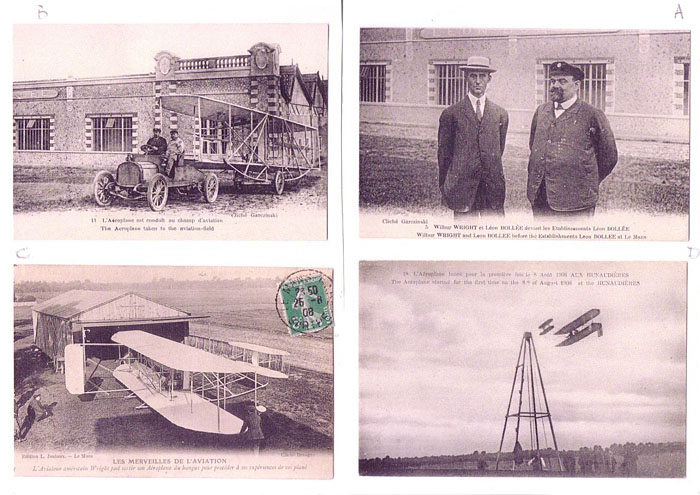
Top : Final preparations for flight. This shows up the Flyer’s skid undercarriage. Wilbur on the right , Leon Bollee left and Wrights French agent Hart O Berg centre. Bottom : Cartoon entitled “ Aviation has its little problems. Bollee left, Wilbur inspecting the wing, watched by Bleriot ( in Bowler) and others. The cartoonist is clearly the same as the one who portrayed Wilbur on the card which fronted the December 2003 Special Wright edition of the Newsletter
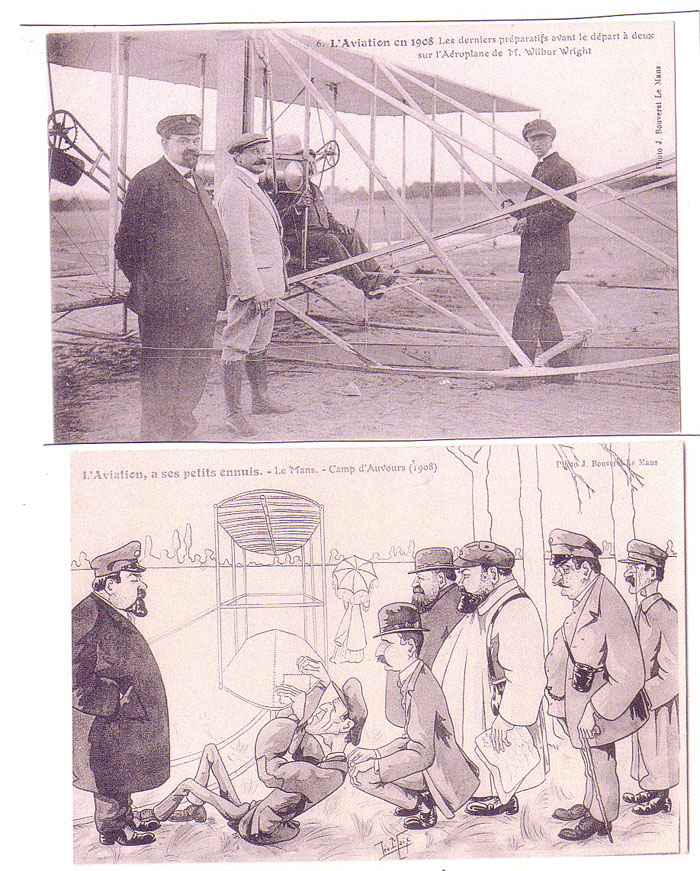
The demand for the Imperial listing seems to be from 25- 30 members, of which at least three would need to have a print copy rather than electronic. Of the rest the majority have known E-Mail addresses but and some others who would accept CD but who either do not have or do not release their E-addresses. There was little agreement on what pictures to include – although numbered Tucks was relatively favoured.
In the interests of getting the information out I therefore plan to proceed as follows.
1) Initially I will supplement the list only with views of Interior cards which are virtually impossible to distinguish solely by written description. This will be about 30 pages of A4 printed double sided.
I will write to those requesting this option with a mail inclusive price .
2) I will E-Mail or otherwise contact all those who responded with interest as to their preferences for delivery by E-Mail or CD and any restrictions on file formats / download capacity.
3) Before either of these I will be approaching contributors for images of any interior cards that they have contributed to the list.
4) There will be no charge for listings distributed by E-Mail . Charges for CD and paper versions will be on a cost recovery base only. These are unlikely to exceed the £ 5 originally quoted for inland mail – any overseas will need to add the extra mail. ,
Although the flow of new entries has slackened they are still coming in.
Here is a French artist card of an Albatross/Frobisher by Petit.
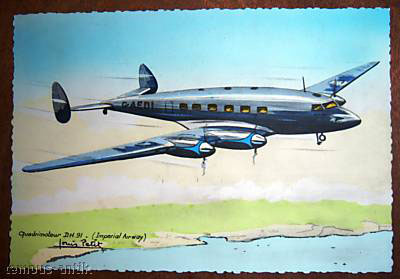
One issue which exercises collectors is the status of the “postcard backed photo” – prevalent in the 1930’s but still being produced today. This is where a private photographer has photos printed on postcard-quality paper with some combination of divided back, address lines and “Post Card” text on the back. Although they may not be true postcards they are usually rare, being produced in very small quantities and often feature unique scenes . Although printed text is rare, hand written information can often be present. One such card, from the York PC show was the trigger for this article.
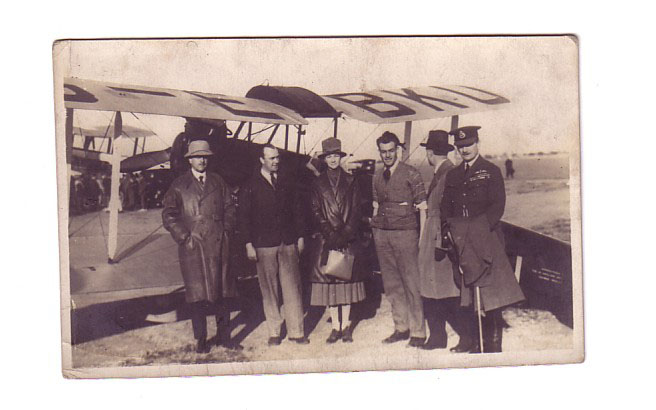
Writing on the back identifies Sir Samuel & Lady Hoare, Captains Stack and Leete and Air Vice Marshall Salmond. They are standing by DH Moth G-EBKU with a larger biplane in the background. Stack is first from left between Lord & Lady Hoare , then Leete , then ? with the Air Vice Marshall on the right. This cast of people and planes is enough to fix the picture at the meeting of Stack & Leetes flight to India Nov/Dec 1926 in Moths EBKU and EBMO and the first Imperial flight to India by DH Hercules G-EBMW which left Croydon 27th Dec carrying the Hoares. This was at Bushire, Iran where the Moths paused for 6 days to overhaul engines. Lord Hoare was air minister at the time and Lady Hoare received the DBE just for being a passenger on this flight. Lord Hoare later became foreign secretary , 1st lord of the Admiralty and Home Secretary and was Air Minister again in 1940 before being demoted to ambassador to Spain by Churchill. Stack had served under Salmond in what would now be called counter-insurgency operations in Iraq in the 1920’s. Salmond rose to Chief of the Air Staff and Marshall of the RAF, worked on Aircraft Production in WW2, and after retiring due to ill health in 1943, died aged 87 in 1968 Before telling the Neville Stack story, a few words on his partner Capt Bernard .S Leete. They appear to have met while being employed as instructors by the Lancashire Aero Club at Woodford from 1925. Leete remained in India after this flight , operating air mail and charter services and establishing flying clubs and an aircraft import business. He later joined the Indian Aviation Ministry as Technical officer responsible for licensing flying clubs but has not been traced after 1939. T Neville Stack was well known in the industry in the 1930’s but was not in the first division of publicly known aviators like Mollison,. He was more of an “airmans airman” and the fact that so much can be found about him is due to his frequent appearances in the aviation press. Most of what appears here is due to the fact that the entire archive of Flight magazine from 1909-2004 is now available on-line searchable at www.flightglobal.com/pdfarchive. T Neville Stack was born in 1897 to an Irish landowning family. Serving in WW1 he transferred to the RFC in 1917 and rose to Captains rank with 212 squadron using DH.4s on anti-submarine operations. Post war he worked as an instructor with London & Provincial Aviation but rejoined the RAF in 1921 and served in Iraq until 1925 on airmail and “air-policing” duties. Later when he was a frequent participant at air shows , it was a common practice to re-enact these duties using Moths, flour bombs, makeshift “forts” and “arabs” dressed in sheets, tea-towels and blackened-up. From 1925 he was Chief Instructor at the Lancashire Aero Club and credited with saving the club from extinction. The India flight with colleague Bernard Leete was his first long distance venture. Returning to the UK he embarked on the career of a journeyman airman, with various contracts including long distance flights or record attempts and participation in air races. In many of these events he was the “chauffeur” for wealthy owners who participated as passengers. However, as his address in 1932 was 7 Park Lane W.1 the amount of wealth was relative. The following activities have been traced during the period to 1934 :
Here are some cards of types flown by Stack during this period Top Vickers Vivid G-EBPY flown by Stack for owner J R Chaplin 1931 (PC back photo) Middle : Airspeed Courier (Real Photos 202) Bottom : Miles Hawk Major as flown by Stack 1934(Real photos 226). Right : Blackburn Lincock G-ABFK(PC back photo – text Capt Stack & Capt Andrews explaining the Lincock to (Belgian) General Guillaume) – Stack on left.

Stacks return to long distance flying was with the one-off Spartan Mailplane G-ABLI as here by Real Photos 33.
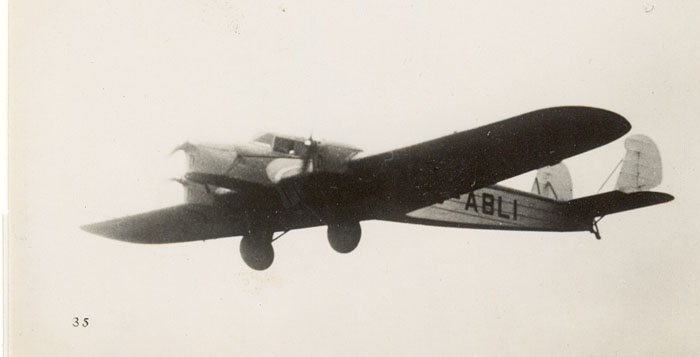
Stack, planned to take part in the McRobertson Melbourne Air Race in October 1934 and personally commissioned a special version of the Airspeed Envoy, named the Viceroy. The Envoy was a 6/8 seat airliner used by a few British Airlines, the Kings Flight, Japan Air Transport, South African Airways, Czech Airways and “executive” use in Uk, India and Czechoslovakia This one G-ADBA was with Olley Air Service ( Anon K1493)

For Stack the race was a catastrophe. He had paid Airspeed £1000 deposit on the Viceroy , hoping to pay the balance from various race proceeds. In particular, he planned to be the last to leave Mildenhall and carry film of the departure of the rest of the competitors. The Viceroy with Stack and partner S L Turner only got as far as Athens due to a variety of minor faults. Stack then sued Airspeed to try and avoid payment of the balance but lost the case . The re-possessed Viceroy was too specialised for Airspeed to find a buyer until 1936 when the Spanish Republican Air Force would take whatever it could find. The case against Airspeed damaged his finances as well as his reputation and, probably in consequence, in 1935 Stack flew scheduled passengers for the first time. He was employed by Hillmans Airways as “Air Superintendent” = Chief Pilot for their DH Dragon Fleet.This is not a postcard but is included as the only clear image of Stack that has been located apart from the initial India flight shot. ( from Air Britain – The Triple Alliance –predecessors of the 1st British Airways)
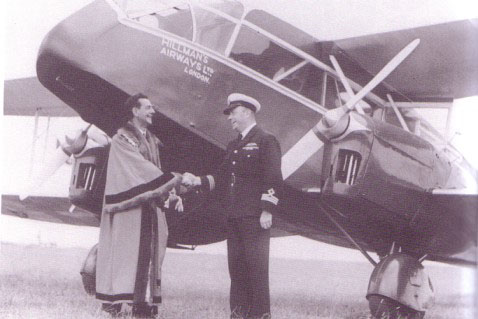
Stack is shown with the Mayor of Ramsgate on the occasion of the opening of service by Hillman DH Dragon to Ostend. July 1935. Ted Hillman had built up a bus and coach business post WW1 and was famous for having described pilots as basically bus-drivers - his operation was a sort of proto-Ryanair. However he did employ Amy Johnson as one of his “bus-drivers” in Summer 1934. It is not clear how long Stack was with Hillmans but he seems to have taken to the management role, introducing uniforms and standard procedures but also providing proper accommodation for pilots and ground staff. However, by 1938 he is delivering military aircraft to Turkey and then takes long-term employment as test pilot to the shadow aircraft factory established by Austin Motors at Longbridge, Birmingham to build the Fairey Battle. This is a Dutch card of 3 Battles in formation from 1939/40

In July 1939 one of these landed short after undercarriage failure , leaving Stack with two broken legs. There is then a gap in the records until he re-appears in 1944 as a Lt Commander in the Fleet Air Arm based in Ceylon (Sri Lanka) and charged with taking over an ad-hoc outfit manned by Australians providing communication between naval bases with Fairey Swordfish – anything that could not go inside , like motor-bikes, was tied to the outside. The task was to regularise this operation as 742 sq RN – which probably did not appeal to the Australians but also introduce the Beech 18, which probably did. By 1944 the Naval D-18s were probably in bare metal like this one VH-SAU – as it happens also Australian, on a company card from Alligator Airways , Kununurra WA

Stack appears to greatly enjoyed this part of his career and he wrote it up in a book (quoted as either “The Flying 42nd” or “The saga of 742”) after it disbanded in 1946. The book included words ( probably censored) and music of the songs of the squadron. Stack had earlier issued provate recordings of his own singing with banjo/ukulele accompanyment in 1934! His time with 742 may have been his personal peak – he seems to have styled himself Lt Commander rather thasn “captain” subsequently. Post war, he returned to airline work and was with Skyways, Lancashire Aircraft Corp and Hunting at various times 1947-1948. Part of this time was spent in India during the partition evacuations and his last job was as manager of Orient Airways, a DC-3 operator in Karachi, Pakistan . Flight magazine reported his death , near Karachi “ in tragic circumstances” “ having been on the point of a breakdown” in Feb 1949, aged 52. These all appear to be indications of suicide in the language of the time. He left a son, also T Neville Stack, which made some of the research a bit complicated. Unlike his father , whose career was to say the least unstructured, the son pursued a classic and successful RAF career, although without much drama. A Cranwell Cadet, he won the Sword of Honour as best all-round cadet of his year , 1939. By 1943 he was with Coastal Command Sunderland Squadron 201. This card of a Sunderland, but L5798 of locally based 210 Squadron, is a 1940 view recently issued by Oban Museum on the west coast of Scotland
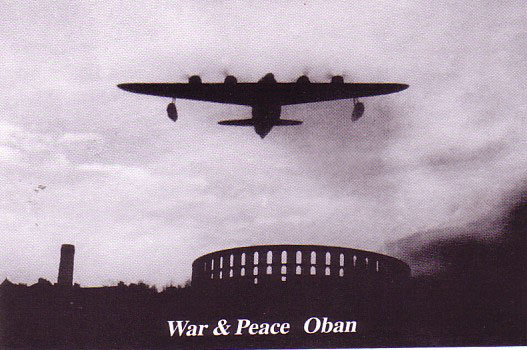
He rose through Coastal Command to staff level. His only subsequent operational command was in charge of an airlift of paratroops from Cyprus to Jordan in support of King Hussein in 1958. He returned to Cranwell as its head and by 1972 was Air Marshall commanding Training Command and had been knighted. Made an Air Chief Marshall in 1976 he retired in 1978 and died aged 74 in 1994 -
|